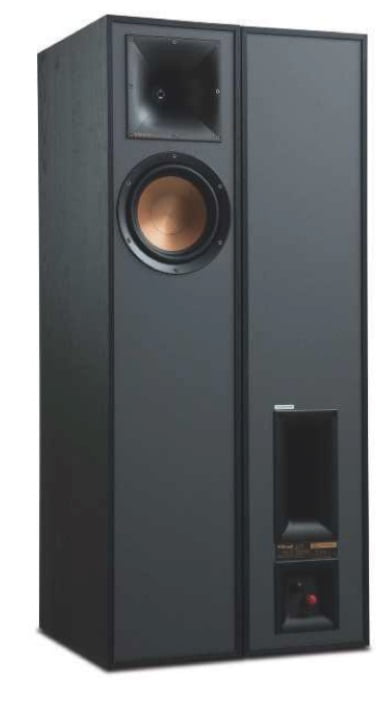Klipsch R-610F Review
Klipsch refuses to pander to convention, and so has something of a cult following. The R-610F shows why. Read our Klipsch R-610F Review.
DETAILS
PRODUCT Klipsch R-610F
ORIGIN USA
TYPE 2-way floorstanding loudspeaker
WEIGHT 16.3kg
DIMENSIONS (WxHxD) 240 x 940 x 384mm
FEATURES
- 1 x 25mm horn- loaded aluminium dome tweeter
- 1x165mm lMG mid/bass driver
- Quoted sensitivity 94dB/1W/1m (8ohm)
DISTRIBUTOR Henley Audio Ltd.
TELEPHONE 01235 511166
WEBSITE henleyaudio.co.uk
Of not quite the loftiest tower in the group, the R-610F is certainly the deepest and so has quite a chunky physical presence. Suffice to say, the big, bulky and black floorstander from the company’s entry-level ‘R’ lineup isn’t the kind of speaker that dissolves into the decor. And, sans grille, the spun copper finish of its mid/bass driver is arguably even more eye catching than Monitor Audio’s three-driver orange array.

The R-610F’s Tractrix horn features a circular throat around an aluminium diaphragm that fires into a square 90° x 90° mouth. The tweeter’s so-called linear Travel Suspension uses Kapton, an extremely light and rigid material claimed to improve resolution and detail. A matching horn-shaped bass reflex port on the rear claims more powerful low end with reduced port noise and distortion.
Teamed with the 25mm aluminium dome is that softly gleaming 165mm mid/bass driver. The copper-coloured cone is actually Injection Molded Graphite, which Klipsch says delivers “remarkable low-frequency response, with minimal cone breakup and distortion” while contributing to the speaker’s impressive 94dB efficiency – comfortably the highest of the group.
Sound quality
While startlingly bold and projected well into the room, Lizz Wright’s vocal acquires a slight bloom at some frequencies that detracts from the purity of the production. On the other hand, there’s an immediacy and palpable physicality to the ensemble’s performance that’s powerfully engaging and thrillingly steps up a gear when the gospel choir joins in, though the slightly grey, grainy and opaque hue of the recording of massed voices isn’t as sympathetically handled as it is by the Oberon 5.

It isn’t hard to appreciate why the Klipsch sound has such a loyal following. It may not be the smoothest or most refined, but that’s kind of the point. It isn’t very ‘hi-fi’ in the polite sense of the term, eschewing neutrality and evenness in pursuit of believable dynamics and drama, which some would argue contributes more to the enjoyment of music than a ruler-flat frequency response.
As you might expect, Propaganda all but explodes into the room, spraying EDM machine gun bursts across the soundstage with such gusto, you almost feel the need to duck. It’s much the same deal with Lump’s Late To The Flight, which has a marginally larger than life feel to it here, especially apparent in the track’s generous low-frequency content.
The key word here is ‘life’, which the Klipsch grants the track in spades. No, it isn’t a speaker that feels entirely comfortable with Krall or Wright, though that palpable, in-the-room quality has its moments. Rather, the R-610F is determined, dynamic and dangerous to know, and there are some definite upsides to that
Verdict
When you purchase through links on our site, I may earn an affiliate commission. Here’s how it works.
AMERICAN PIONEER
Paul Wilbur Klipsch was an American audio pioneer and arguably the guy who made the greatest contribution to music reproduction from his shed. It’s where, in 1946, he designed and built what was later to be called the Klipschorn speaker with the goal of bringing live music into his living room. The shed is now a fully fledged factory with its own production line and the company’s headquarters have moved to Indianapolis. During his service at the Southwest Proving Grounds, Klipsch refined his design. The story goes that visitors to his quarters were amazed by the lifelike sound and encouraged him to start his own business. He received a patent in 1945, registered the name Klipsch & Associates in 1946 and began making each speaker with his own two hands until he hired his first employee in 1948. The rest is history and the Klipschorn is the only speaker in the world that’s been in continuous production for over 70 years.













I would love to own a pair of them, replacing my Boston Acoustic A23.
Beautifully written review.
It is just a shame that one cannot positively gain true definition from its content.
Personally, I would want an unbiased honest description of the speakers – not an artist’s abstract shower of a random bouquet in need of interpretation.
But that’s just “me”.